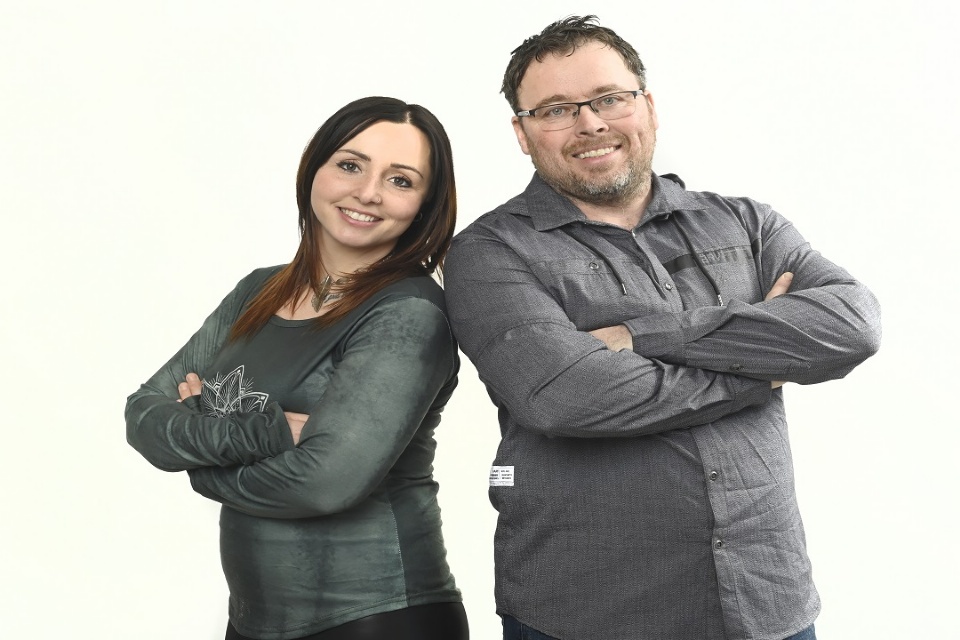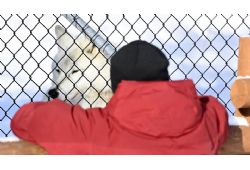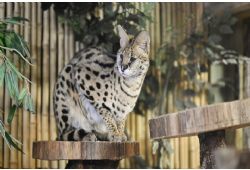You may have heard of Émilie Ferland and Clifford Miller from the TV show and book Un zoo pas comme les autres. Yet Miller Zoo’s story began long before the popular TVA show. It’s above all a love story in which animals play an integral part.
It all started in 2011, when Ferland and Miller, founders of Miller Zoo, wanted to rescue a young doe whose mother had been hit by a car. As there was no refuge in the area that could accommodate the animal, they decided to start the process for a license to keep animals in captivity. As they were both animal lovers, they had already been entertaining the idea of opening an educational farm. Already living on the grounds of the current zoo, in the middle of the woods, they lived in an ideal environment to be able to help injured wild animals.
In the first year, they began to welcome deer, raccoons and squirrels. Recognizing that there was a demand from the public to observe animals in their natural environment, they began offering tours of the little farm they had created, using the money raised to help even more animals and by reinvesting it in order to develop new facilities, such as hiking trails. Within the first year, mainly through word of mouth, they were able to attract around 10,000 visitors.
Yet Miller Zoo was not yet a "zoo". “The name 'zoo' comes from a family joke,” explains Ferland. “People were like, ‘Hey, you've got a zoo on your hands!’ So, when it came time to register, that was the name we chose.”
That’s how the real story of Miller Zoo began. With a name like that, zoos contacted Ferland and Miller to find out if they were willing to take newborn lions or tigers or those that were at the end of their lives. They realized that there was a need to place exotic animals when there were, for example, unplanned births or if they were not good-looking enough to be displayed at a zoo.
“We were offered two white tigers that no one wanted, so we decided to take the leap in acquiring a professional license to care for animals,” says Ferland. “What’s more, the regulations had just changed. Previously, to get the permit, you needed a full-time veterinarian on zoo grounds. It was therefore very expensive. Now, you need a full-time vet, which is different. We were therefore able to start the process and become a zoo.” Ferland and Miller seized the opportunity, and the zoo has grown bigger and bigger over time.
Although it’s called a "zoo," Miller Zoo is more of a zoological garden. Rehabilitation, awareness and education are at the heart of its founders’ values. The park's hiking trails allow you to observe more than 150 animals of 60 different species in their natural environment. Black bears, deer, moose, wolves, pumas, lions, Asian otters, lemurs and more!
Over the years and with an increasing number of animals, Miller Zoo has evolved, getting bigger and bigger. The money generated by visits is constantly reinvested to improve the animals’ shelters and their quality of life. “One of the steps we have taken is to conserve endangered species, whereas before we focused more on rehabilitation,” says Ferland.
The educational mission is also very important within Miller Zoo. “In order to protect animals, you have to understand them and learn to love them. We want to share the history of our animals to raise awareness. People must also be taught to live with animals,” says Ferland. The zoo has installed many explanatory panels that tell the story of the animals at Miller Zoo and allow patrons to learn more about the different species that inhabit it. Several panels also explain the mistreatment that certain animals undergo, in particular because of poaching. Environmental awareness, such as not throwing rubbish on the ground, is also being promoted throughout the park.
Miller
Zoo in the Era of COVID-19
Miller
Zoo's biggest challenge with COVID-19 is, like many businesses, the uncertainty
of the situation. Not knowing how long the crisis would last, Ferland wondered
how she was going to be able to provide for her animals without the cash flow
generated by visitors. Now that the situation is improving, she doesn’t want to
limit the number of daily visits to the zoo. She and Miller have widened the
walking trails and established a one-way circuit so that visitors don’t pass too
close to each other. Antiseptic gel dispensers are available to visitors at the
entrance. Posters are seen all over the zoo grounds to encourage physical
distancing in a humorous way. For example, one poster encourages visitors to
leave the equivalent of a kangaroo jump or the length of a tapir between them.
A
Couple that Compliments One Another
Where
does Clifford and Émilie's passion for animals come from? “I have always loved
animals. When I was little and came home from school, I picked up ones that
were injured by the side of the road,” explains Ferland. “Whenever I could help
an animal, I did. I was bullied when I was younger, I was lonely, so animals
were my friends. Clifford's mother had a small stray cat shelter when he was
young, so he always lived with animals too. In my opinion, animals make people
better people.”
You can feel the passion that drives Ferland as she recounts stories of her animals and the abuse some suffered before arriving at Miller Zoo. She explains that she’s happy to have started her project on a smaller scale, because she was able to learn the best way to take care of her animals before the zoo got bigger and more popular. She also talks about the mutual aid that exists between the different shelters. She doesn't hesitate to ask for help if she’s less familiar with a certain species, and vice versa. Everyone works together for the welfare of animals.
How does a couple manage a project like Miller Zoo? Ferland explains that she and Miller are very complementary. They do not have the same strengths and weaknesses. “We work together, but we hardly see each other since we don't take care of the same sectors,” she laughs. Miller, a woodworker by trade, is primarily responsible for repairing trails, building shelters and infrastructure, and more. Ferland takes care of injured animals. “We work as a team when we take care of dangerous animals, to clean their shelters, for example,” she explains.
She admits that the most stressful part is caused by difficult financial times, like in the early days of the zoo. What does the future hold? Miller would like Miller Zoo to become the gold standard in the world of zoos. Ferland, on the other hand, would like to continue expanding the animals' shelters, so that it’s almost as if they are returning to the wild. “It's the best of both worlds, as they will have habitats as far as the eye can see, free of predators,” she says. In keeping with an educational perspective, she also plans to create an insectarium. She wants to educate people about insects so that they understand how essential they are and that they should not be feared.
Miller Zoo is an inspiring place that continues to grow with all the love that Ferland and Miller have given to it to help their animals. Miller Zoo is open Monday through Sunday 9:30 am to 5 pm. To learn more about the zoo and to consult pricing, visit the website at millerzoo.ca.

 In The Latest Issue:
In The Latest Issue:




 BY:
BY: 

Tweet
Share